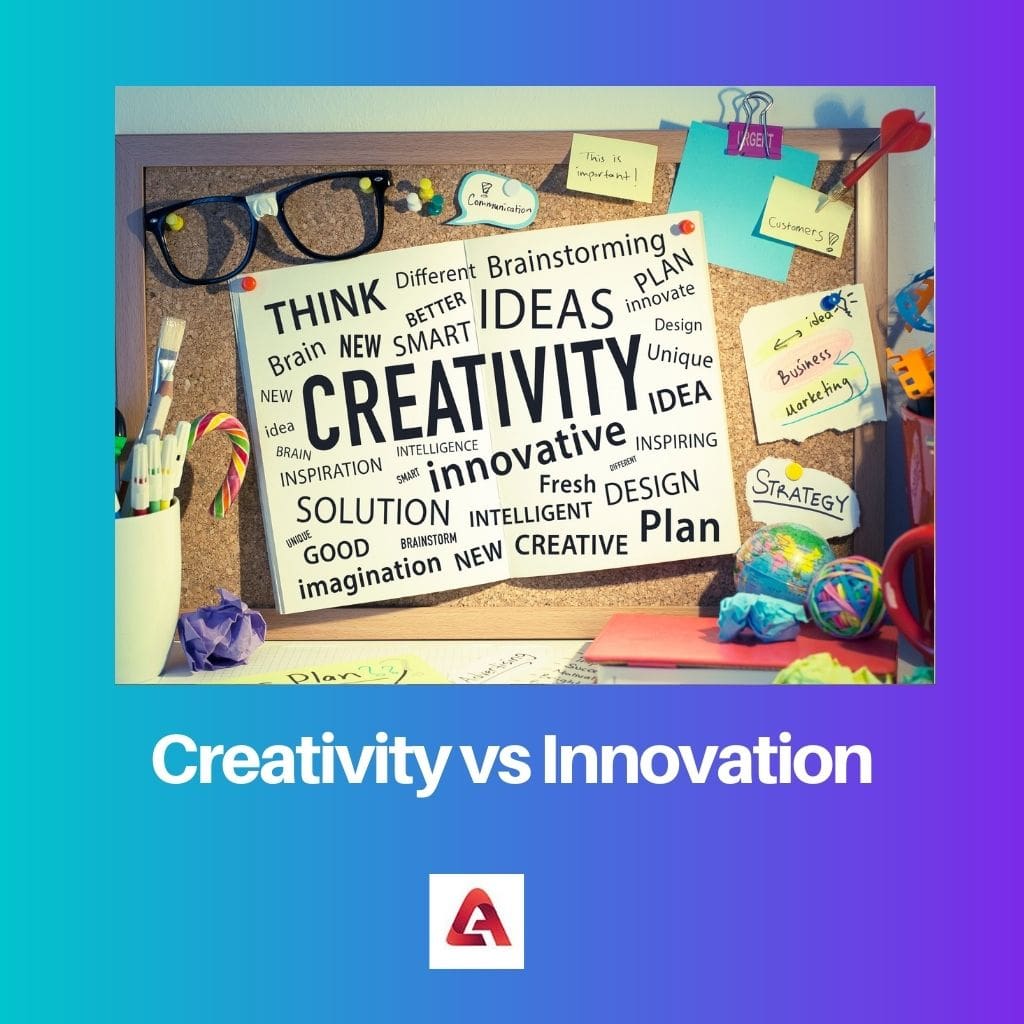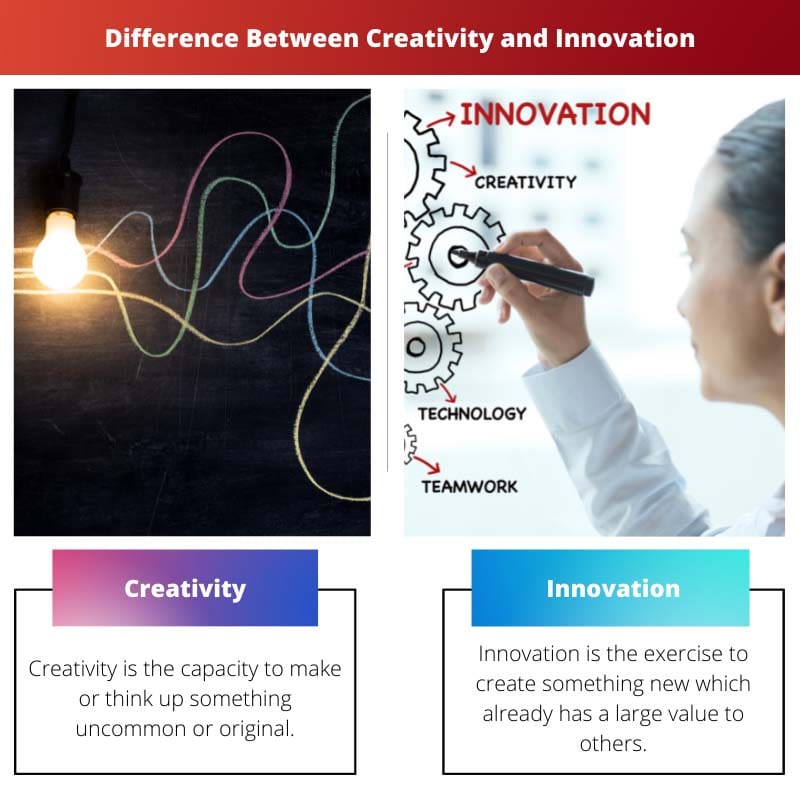Creativity is the spark of imagination, igniting novel ideas within individuals, while innovation is the process of bringing those ideas to fruition, requiring meticulous planning and execution. Time allocated for creativity allows for exploration and ideation, whereas time for innovation demands structured implementation and refinement, balancing the freedom of creation with the discipline of execution to realize transformative change.
Key Takeaways
- Creativity is the ability to generate new and original ideas or concepts.
- Innovation turns new and original ideas into practical and valuable products or services.
- Creativity is focused on imagination, while innovation is focused on execution and implementation.
Creativity vs Innovation
Creativity is the starting point for innovation; the two concepts differ in terms of their focus and outcomes. Creativity is about generating new ideas, while innovation is about bringing those ideas to fruition and creating value. Innovation requires creativity, but creativity can stand alone.

Innovation can be risky, but creativity is not at all risky as it’s just an idea. Creativity is when a potential mind is released to conceive new ideas.
These ideas can demonstrate in any number of ways, but mostly they are the thoughts we are being able to feel, see, smell, touch, etc.
Nonetheless, these creative ideas can be taken as an analysis expression within one’s mind. On the other hand, innovation can be measured thoroughly.
This is about using a way to introduce change into nearly a balanced order. To make an innovation, one will require a certain amount of work to make the idea real.
Comparison Table
| Feature | Creativity | Innovation |
|---|---|---|
| Focus | Generating new and original ideas | Implementing creative ideas to create value |
| Process | Imaginative, divergent thinking, exploration | Action-oriented, convergent thinking, execution |
| Outcome | New ideas, concepts, or possibilities | New or improved products, services, or processes |
| Measurable | No, difficult to quantify | Yes, can be measured by impact, adoption, or other metrics |
| Risk | Low, primarily focuses on exploration | High, involves implementation and potential for failure |
| Resources | May not require significant resources | Often requires resources like funding, technology, and personnel |
| Examples | Writing a song, painting a picture, coming up with a new business idea | Developing a new vaccine, creating a self-driving car, improving a manufacturing process |
What is Creativity?
Creativity is not confined to the domain of the arts; it permeates every aspect of human endeavor, from scientific breakthroughs to technological innovations and entrepreneurial ventures. At its core, creativity involves breaking away from conventional thinking patterns and embracing a mindset of exploration and experimentation. It is about challenging assumptions, taking risks, and embracing uncertainty to uncover new possibilities.
The Creative Process
The creative process is nonlinear and unpredictable, characterized by phases of incubation, insight, and elaboration. It begins with immersion in a problem or domain, followed by a period of subconscious processing where ideas percolate beneath the surface of conscious awareness. This incubation phase is crucial for allowing disparate pieces of information to coalesce into novel insights. The “aha” moment of insight emerges unexpectedly, sparked by a serendipitous connection or a sudden shift in perspective.
Factors Influencing Creativity
Creativity is influenced by a myriad of factors, including individual traits, environmental stimuli, and social context. Psychological factors such as openness to experience, tolerance for ambiguity, and intrinsic motivation play a significant role in fostering creative thinking. Additionally, environmental factors such as diverse perspectives, collaborative interactions, and a supportive culture of experimentation can cultivate an atmosphere conducive to creativity.
Cultivating Creativity
While creativity is regarded as an innate trait, it is also a skill that can be nurtured and developed through deliberate practice and exposure to diverse experiences. Engaging in activities that stimulate the imagination, such as brainstorming sessions, creative exercises, and exposure to different cultures and disciplines, can broaden one’s creative repertoire. Furthermore, fostering a culture that values experimentation, tolerates failure, and rewards innovation can unleash the creative potential of individuals and organizations alike.

What is Innovation?
Innovation is more than just the creation of new products or technologies; it involves the systematic application of creativity to solve problems and seize opportunities. It encompasses a spectrum of activities, including research and development, design thinking, market analysis, and strategic planning, aimed at bringing new ideas to market and improving existing systems. At its core, innovation is about driving meaningful change and generating measurable outcomes that enhance efficiency, productivity, and quality of life.
The Innovation Process
The innovation process follows a structured framework, beginning with ideation and concept development, followed by prototyping, testing, and commercialization. It involves iterative cycles of experimentation and refinement, where ideas are validated, iterated upon, and scaled to reach broader markets. Central to the innovation process is the ability to identify emerging trends, anticipate future needs, and adapt quickly to changing circumstances to maintain a competitive edge.
Types of Innovation
Innovation can take various forms, ranging from incremental improvements to disruptive breakthroughs that fundamentally alter the status quo. Incremental innovation involves making small, incremental changes to existing products or processes, whereas radical innovation involves introducing entirely new concepts or paradigms. Additionally, innovation can be classified as product innovation (introducing new products or services), process innovation (improving operational efficiencies), business model innovation (redefining how value is created and delivered), or social innovation (addressing social and environmental challenges).
Drivers of Innovation
Innovation is driven by a combination of internal and external factors, including technological advancements, market dynamics, regulatory changes, and shifts in consumer preferences. Organizations that foster a culture of innovation by encouraging risk-taking, fostering collaboration, and rewarding creativity are better positioned to adapt to changing market conditions and seize new opportunities. Moreover, strategic partnerships, open innovation initiatives, and ecosystem collaboration can facilitate cross-pollination of ideas and accelerate the pace of innovation.
Cultivating Innovation
Cultivating a culture of innovation requires a holistic approach that addresses organizational structures, processes, and mindset. It involves empowering employees to experiment, fail fast, and learn from mistakes, while providing them with the resources and support needed to pursue bold ideas. Additionally, creating dedicated innovation hubs, establishing cross-functional teams, and incentivizing idea generation can foster a collaborative environment where innovation thrives.

Main Differences Between Creativity and Innovation
- Nature:
- Creativity involves generating original ideas, concepts, or solutions.
- Innovation involves implementing and commercializing those ideas to create tangible value.
- Process:
- Creativity is the initial stage where ideas are conceived and explored, with a focus on ideation and brainstorming.
- Innovation is the subsequent stage where ideas are refined, developed, and brought to market through systematic planning, testing, and execution.
- Focus:
- Creativity emphasizes imagination, divergent thinking, and exploration of possibilities.
- Innovation emphasizes practical application, problem-solving, and delivering solutions that meet specific needs or address identified challenges.
- Outcome:
- Creativity produces novel ideas or concepts that may or may not have immediate practical applications.
- Innovation results in tangible outcomes such as new products, processes, or business models that create value for stakeholders and drive organizational growth.

- https://creativityworkshop.com/what-is-creativity.html
- https://www.hbs.edu/faculty/Pages/item.aspx?num=13672

The distinction between creativity and innovation is clearly articulated in the article, providing an in-depth understanding of the interrelated yet distinct concepts.
This article clearly differentiates creativity from innovation and effectively highlights the importance of both in society.
I agree, creativity and innovation are conflated but they’re separate and equally vital components of progress.
The breakdown of creativity and innovation into distinct characteristics is enlightening and informative.
The delineation of creativity and innovation highlights their critical roles in driving societal and economic development.
This article enhances the understanding of creativity and innovation as catalysts for problem-solving and progress.
The breakdown of creativity and innovation processes provides a holistic perspective on their influence in diverse domains.
The article’s detailed analysis of creativity and innovation effectively showcases the indispensable role of creativity in fostering innovation.
Absolutely, the article’s thorough perspective on the multifaceted nature of innovation and creativity contributes significantly to understanding the core concepts of inventive thinking.
This article provides insightful distinctions between creativity and innovation. The concise comparison table effectively summarizes the main differences.
Exactly, the article’s detailed description of creativity and innovation sheds light on the essential characteristics of both concepts.
The distinction between creativity and innovation is clearly presented, emphasizing their distinct processes and outcomes.
Indeed, understanding this difference is essential for fostering a culture of creativity and supporting innovation.
This breakdown facilitates a deeper understanding of the contributions and impact of creativity and innovation.
This post offers a comprehensive comparison between creativity and innovation, which is exceedingly helpful in understanding their roles.
Absolutely, this article provides valuable insights into the significance of creativity and innovation in our society.
The article provides valuable insights into the sources of creativity, emphasizing the role of personal experiences, observation, and collaboration. It’s enlightening.
The detailed perspective on the multifaceted nature of innovation and its real-world impact contributes significantly to understanding the importance of innovative thinking.
I agree, the article effectively highlights the multifaceted nature of creativity, emphasizing its profound impact on various aspects of life and society.
The article presents a lucid breakdown of the core characteristics and the process of creativity and innovation, offering a comprehensive perspective on these essential concepts.
The article effectively captures the essence of creativity and innovation, elaborating on their individual and collective contributions to societal progress.
The description of the core characteristics and the process of creativity and innovation effectively captures the essence of both concepts.
Indeed, the article portrays the intricate nature of creativity and innovation, providing a holistic view of their significance.
I appreciate how the article articulates the benefits of creativity and innovation, illustrating their individual and collective contributions to society.
The detailed breakdown provided offers an extensive understanding of creativity and innovation, shaping a comprehensive perspective on both concepts.
This article effectively underscores creativity as the seed of innovation and reinforces their indispensable relationship.
Understanding the significance of creativity is crucial for fostering innovation and driving positive change in society.
The comparison table between creativity and innovation offers a nuanced understanding of their distinct yet interconnected nature.
Innovation is an integral part of creativity that makes it scalable and beneficial for society.
I think creativity has its own unique value as the source of innovation, providing a foundation for progress.
The breakdown of the creativity and innovation processes reveals their intrinsic differences and transformative potential.
This article emphasizes the interdisciplinary nature of creativity and innovation, underscoring their value in various domains.
The explanation of creativity and innovation as divergent processes with different outcomes is thought-provoking.
The comparative analysis of creativity and innovation effectively highlights their unique roles in driving progress.
This article effectively showcases the interdependent relationship between creativity and innovation as precursors for societal progression.
The breakdown of the creativity and innovation processes reveals their intrinsic differences and transformative potential.
The comparison table between creativity and innovation provides a comprehensive understanding of their respective contributions.
The clear differentiation between creativity and innovation is well-discussed in this article. It highlights the distinct roles of each and their combined impact.
Absolutely, the article presents a comprehensive analysis of creativity and innovation, elucidating their significance in professional and personal spheres.
Understanding the contrast between creativity and innovation enables individuals to harness their combined power for societal advancement.
The emphasis on the necessity of creativity for triggering innovation and the subsequent societal benefits is noteworthy.
It’s enlightening to recognize the distinct facets of creativity and innovation and their collective impact on socio-economic development.
This article provides valuable insights into the intricate nature of creativity and innovation, offering a profound understanding of their significance.
Creativity is the root of all innovative solutions. The article’s elucidation of the complex aspects of creativity and innovation is commendable.
Absolutely, the article effectively highlights the essential prerequisites and processes involved in both creativity and innovation.
The article thoughtfully emphasizes how collaboration, open-mindedness, and new experiences are crucial sources of creativity.